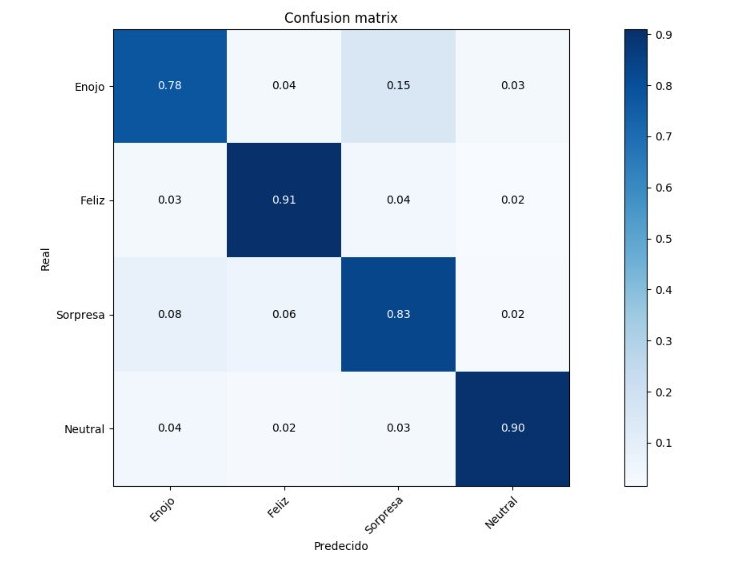Vehicle driver monitoring system based on facial expression analysis.
DOI:
https://doi.org/10.17981/ingecuc.16.2.2020.14Keywords:
artificial intelligence, machine learning, deep learning, computer vision, facial expressionsAbstract
Introduction-When driving, any person is exposed to different stimuli that can lead to accidents. Although numerous technological proposals have been presented to keep the driver monitored, these have overlooked the state of mind in which they driver is, which could have negative effects on the ability to react when driving.
Objective- Find different artificial intelligence alternatives for the permanent analysis of drivers' faces, in order to find a good model for classifying facial expression (happy, angry, surprise, neutral).
Methodology- The methodology proposed consists in the selection of a database that is pre-processed, in orden to later train different models and make precision comparisons between them.
Results- It is possible to find a precision greater than 80% in the detection of the user's mood and then the model is migrated to a portable monitoring system.
Conclusions- In this particular case, traditional machine learning methods consume less processing time when classifying, however, they are exceeded in precision by deep learning.
Downloads
References
A. González, F. J. Martínez, A. V. Pernía, F. A. Elías, M. Castejón, J. Ordieres & E. Vergara, Técnicas y Algoritmos Básicos de Visión Artificial. RI, Es.: U de la Rioja, 2006.
F. Chollet, “Deep Learning With Python” Vol. 1, GMT, USA: Manning Publications Co, 2017.
V. Torres & J. Alejandra, “Las Compañías más Grandes en Seguros Generales en Colombia: Un Análisis Comparativo en el Período 2015-2017,” Trabajo de grado, UC, Bog., Co., 2017.
W. Arias & S. B. Chaves, “Analysis Of Fatalities For Crash Accidents in Colombia Between 2011-2015,” Redes de Ingenieria-Rompiendo las Barreras del Conocimiento, vol. Especial, pp. 226–239, 2017. Available: http://revistas.udistrital.edu.co/ojs/index.php/REDES/index
E. G. Fernández-Abascal & M. Chóliz, Expresión Facial de la Emoción, Mad., Esp.: UNED, 2001.
A. Freitas-Magalhães, Facial Action Coding System-Manual of Scientific Codification of the Human Face. RJ. Br.: Escrytos, 2018.
R. Amini, C. Lisetti & G. Ruiz , “Hapfacs 3.0: Facs-Based Facial Expression Generator for 3d Speaking Virtual Characters,”IEEE Trans Affect Comput, vol. 6, no 4, pp. 348–360, 2015. https://doi.org/10.1109/TAFFC.2015.2432794
E. A. Morris & J. A. Hirsch, “Does Rush Hour See A Rush Of Emotions? Driver Mood in Conditions Likely To Exhibit Congestion,” Travel Behav Soc, vol. 5, pp. 5–13, Sep. 2016. https://doi.org/10.1016/j.tbs.2015.07.002
A. Carneiro, P. Cortez & R. Costa, Reconhecimento de Gestos da Libras com Classificadores Neurais a Partir dos Momentos Invariantes de Hu, in Interaction Sudamerica/09SP. Br.: IXTA-SP, pp. 193–198, 2009.
M. G. Kamachi, J. Gyoba & M. J. Lyoons, “The Japanese Female Facial Expression (Jaffe) Database, in “Proceedings of Third International Conference on Automatic Face and Gesture Recognition,” Data Set, Zenodo, pp. 14–16, 14 Abr. 1998. https://doi.org/10.5281/zenodo.3451524
C. E. Thomaz, “Fei Face Database,” Fei Face Databaseavailable, 2012. Available: https://fei.edu.br/~cet/facedatabase.html
S. Li, W. Deng & J. P. Du, “Reliable Crowdsourcing And Deep Locality-Preserving Learning For Expression Recognition In The Wild,” presented at Proceedings of the Ieee Conference on Computer Vision and Pattern Recognition, CVPR, Hnl., Hi., USA, pp. 2852–2861, 21-26 Jul. 2017. https://doi.org/10.1109/CVPR.2017.277
N. Pellejero, G. L. Grinblat & U. Lucas, “Análisis Semántico en Rostros Utilizando Redes Neuronales Profundas,” presentado al XVIII Simposio Argentino de Inteligencia Artificial, ASAI-JAIIO 46, Cord., Arg., pp. 62–71, Sept. 2017. Disponible en http://sedici.unlp.edu.ar/handle/10915/65945
M. Köstinger, P. Wohlhart, P. M. Roth & H. Bischof, “Annotated Facial Landmarks In The Wild: A Large-Scale, Real-World Database for Facial Landmark Localization,” en 2011 IEEE International Conference on Computer Vision Workshops, ICCV Workshops, Bcn., Es., pp. 2144–2151, 6-13 Nov, 2011. https://doi.org/10.1109/ICCVW.2011.6130513
S. Marsland, Machine Learning: An Algorithmic Perspective, 2. Ed., CRC Press, Br. Fl. USA, 2015. https://doi.org/10.1201/b17476
K. Simonyan & A. Zisserman, “Very Deep Convolutional Networks For Large-Scale Image Recognition,” Arxiv Preprint, ICLR, Baff., Ca., pp. 1409–1556, 2014. Available: https://arxiv.org/pdf/1409.1556.pdf
R. S. Jurecki, T. L. Stańczyk & M. J. Jaśkiewicz, “Driver’s Reaction Time In A Simulated, Complex Road Incident,” Transport, vol. 32, no. 1, pp. 44–54, 2017. https://doi.org/10.3846/16484142.2014.913535
B. C. C. Cerezo & E. I. Ortega, “Diseño de un prototipo de casilleros inteligentes, utilizando el carnet universitario y clave de seguridad para el control de acceso a través de una red inalámbrica, mediante la administración de página web y base de datos aplicando tecnología de bajo costo (raspberry y arduino), para beneficio de los estudiantes de la carrera de ingeniería en networking y telecomunicaciones de la Universidad de Guayaquil,” tesis grado, dpto. FCFM, UG, Gquil., Ec., 2018. Disponible en http://repositorio.ug.edu.ec/handle/redug/32565

Published
How to Cite
Issue
Section
License
Copyright (c) 2020 INGE CUC

This work is licensed under a Creative Commons Attribution-NonCommercial-NoDerivatives 4.0 International License.
Published papers are the exclusive responsibility of their authors and do not necessary reflect the opinions of the editorial committee.
INGE CUC Journal respects the moral rights of its authors, whom must cede the editorial committee the patrimonial rights of the published material. In turn, the authors inform that the current work is unpublished and has not been previously published.
All articles are licensed under a Creative Commons Attribution-NonCommercial-NoDerivatives 4.0 International License.


 English
English
 Español (España)
Español (España)






















